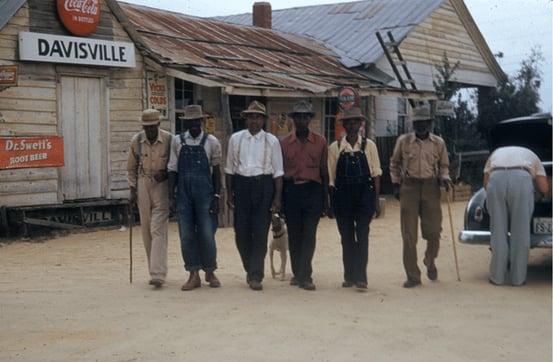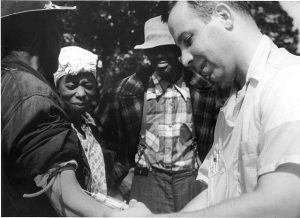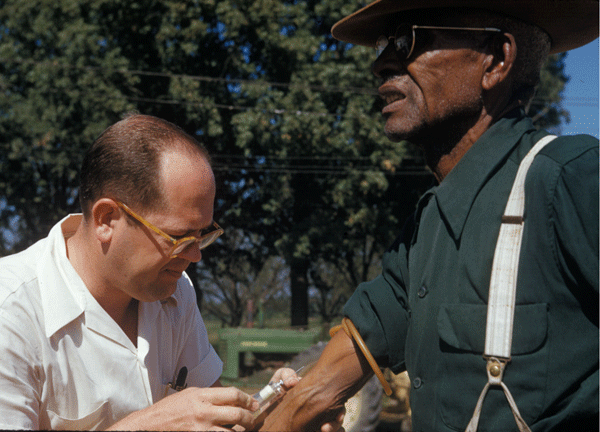The news broke on Tuesday, July 25 1972 thanks to a special Associated Press report for the Washington Star. By the next day, it was on the front page of the New York Times.
Later that year, with congressional hearings led by Senator Ted Kennedy to follow, the racist history of the ‘Tuskegee syphilis experiment’ was finally—and completely—exposed.
Officially named the ‘Tuskegee Study of Untreated Syphilis in the African American Male’, the 40-year study remains one of the most shocking examples of unethical medical experimentation in American history. In 2016, The Atlantic would call it “perhaps the most enduring wound in American health science.”
The experiment, which started in 1932, saw 600 Black sharecroppers from a poor rural county in Alabama recruited by the United States Public Health Service (USPHS) to study the extent of untreated syphilis.
Of the wider group, 399 had latent syphilis and were promised free healthcare to remedy ‘bad blood’ in exchange for their participation, leading them to accept procedures they assumed were treatment.
By the picture painted here … the Tuskegee Study was not a singular event that was reported and processed immediately, but a generational scarring that defined a decade of Black history.
The infected men were never told of their ailment, regardless of the fact they could infect others, and suffer profound healthcare issues themselves.
Later run by the Centers for Disease Control and Prevention (CDC), the study would continue long after penicillin was recognized as standard treatment for syphilis. Without treatment, subjects went blind and deaf, suffered from mental illness, heart disease, and the collapse of their central nervous systems.
By 1972, 128 had died of syphilis or related complications and 40 of their wives had been infected, while 19 of their children were born with congenital syphilis.
Though whistleblowers attempted to draw attention to it for decades, the experiment’s scale and length underscored the depths of its protection and institutional support. Indeed, nearly 50 years after it concluded, the ‘Tuskegee Study’ is still pointed to—by many—as an enduring catalyst for Black distrust in American healthcare.
A distrust in American healthcare
“By the picture painted here,” The Atlantic’s Vann R. Newkirk II wrote of an influential 2016 paper looking back on the experiment’s legacy, “the Tuskegee Study was not a singular event that was reported and processed immediately, but a generational scarring that defined a decade of Black history.”
“That distrust has helped compromise many public health efforts – including those to slow the spread of H.I.V., contain tuberculosis outbreaks and broaden provision of preventive care,” columnist Austin Frakt wrote in a portrait of the relationship for the New York Times, this January.
Amongst other ailments, today Black Americans are more likely to have childhood asthma, diabetes, and heart disease, and three times more likely to die from COVID-19 than white Americans.
Memorably explored by Harriet A. Washington in her 2007 book Medical Apartheid, formalized medical experimentation on Black Americans existed in the United States long before the Tuskegee experiment was conceived.

In the 1840s, Dr. J. Marion Sims conducted experiments on female slaves in Montgomery, Alabama, often without anesthetic. Though still recognized as the “father of modern gynecology”, Sims’ early practices are now recognized as racist. A statue of him, in New York, was taken down in 2018.
The ‘Tuskegee Study’ came to life in 1932 when the venereal disease section of the USPHS formed a study group to look at untreated syphilis in Black Americans for up to a year, following up with treatment.
Funding issues would see the treatment phase canceled, but the study would continue, as directed by agency head Taliaferro Clark.
Thomas Parran Jr, a prominent venereal disease reformer who’d later become the Surgeon-General, helped establish the test location in Macon County, Alabama. Dr. John Charles Cutler, who formerly oversaw a similar U.S.-led program in post-World War II Guatemala, would later become involved.
The study was built on the ground with the help of USPHS regional experts from Arkansas, the Tuskegee Institute, and with the blessing of several leading local Black medical professionals.
‘Special free treatment’
For the participants, which included a 201-strong control group who didn’t have syphilis, the study was sold as a ‘special free treatment’ from the government.
A fine proposition for any American during the Depression, the study also offered subjects free hot meals, free physicals, and free burial insurance.
“All I knew was that they just kept saying I had bad blood – they never mentioned syphilis to me,” survivor Charlie Pollard said, in James H. Jones’ 1993 book Bad Blood: The Tuskegee Syphilis Experiment. “Not even once.”
In 1947, penicillin was seen as a proper way to fight syphilis with the USPHS opening up many centers around America. Yet the Tuskegee group was prevented from using it.

Despite a handful of complaints in the 1950s, Detroit physician Dr. Irwin Schatz was the first to draw real attention after reading a medical journal report on the study published in 1964.
“I am utterly astounded by the fact that physicians allow patients with a potentially fatal disease to remain untreated when effective therapy is available,” Schatz, the father of current U.S. Senator Brian Schatz, wrote in a letter to the report’s authors.
“I assume you feel that the information which is extracted from observation of this untreated group is worth their sacrifice. If this is the case, then I suggest the United States Public Health Service and those physicians associated with it in this study need to reevaluate their moral judgments on this regard.”
Peter Buxtun, a white epidemiologist, and Bill Jenkins, a Black statistician, tried to raise alarm from inside the agency as the decade continued, but the study, which had the support of the American Medical Association (AMA) and National Medical Association (NMA), continued. Buxtun would eventually leak the story to Jean Heller, of the AP, in 1972.
The CDC formed an advisory panel to re-evaluate the study, forcing it to quickly wrap up. Sen. Kennedy took up the cause, leading Buxtun and other officials to testify in Washington D.C. By that time, only 74 of the original 600 study participants were still alive.
All I knew was that they just kept saying I had bad blood – they never mentioned syphilis to me. Not even once.
In 1973, a group of survivors launched a lawsuit against the government, which, in settlement the following year, would see them receive $10 million and free medical treatment for life. 11 children of the study’s subjects still receive related healthcare benefits today.
Congress would later pass the National Research Act in 1974, and create a congressional commission to ensure strict regulation of any future clinical trials. Informed consent and accurate reporting of test results would become the law.
Those directly involved have since been shamed within medicine. Once celebrated as America’s surgeon-general during WW2, Parren Jr has had his name removed from a University of Pittsburgh campus building, and from a lifetime achievement award recognizing the raising of awareness of venereal diseases. Cutler, who died in 2003, has lost his prior standing in the medical community.
A Presidential apology, and a Marvel hero
Official recognition of the pain imparted by the study was finally acknowledged on May 17, 1997, when President Bill Clinton delivered the United States’ official apology at the White House, in front of five of the experiment’s last eight survivors.
“What was done cannot be undone,” he said. “We can stop turning our heads away. We can look at you in the eye and finally say on behalf of the American people, what the United States government did was shameful, and I am sorry.”
Clinton’s Tuskegee apology might have been one of his most moving speeches as president, but perhaps a more definitive mark on American culture was made six years later when Marvel published Truth: Red, White, and Black.
Written by Robert Morales, the 2003 seven-comic series explored a sub-plot of the Captain America storyline where a regiment of Black WW2 soldiers had medical experiments conducted on them, to re-discover the ‘super soldier’ formula that created the Marvel icon.
In the series, directly inspired by the Tuskegee Experiment, only one Black soldier survived, to be known as the ‘Black Captain America.’
The following year, Ernest Hendon—the last participant of the Tuskegee Study’s ‘enduring wound’—died, in Opelika, Alabama. He was 96.



